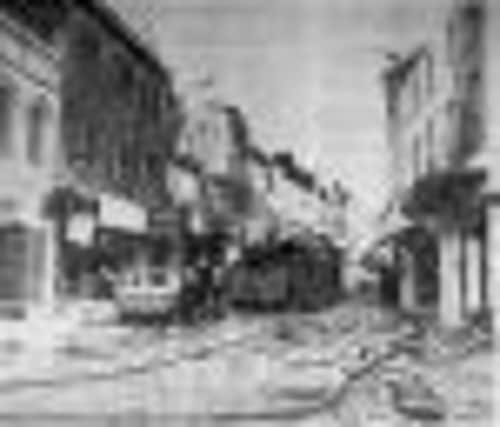TV documentary sparked memories of Ballymena bomb devastation


After it was shown last week, social network sites were inundated with comments about the darkest days of our recent history and users of Facebook in the Ballymena area were no exception.
While younger people had been shaken by the sheer awfulness of the event, others, who had vivid memories of the time reflected on just how big an impact the campaign of terror, murder and mayhem had made on their psychology.
Advertisement
Hide AdAdvertisement
Hide AdTime and again, Facebookers made reference to the virtual destruction of Ballymena town centre back in 1979. It was not the first time the area had been blasted, nor was it to be the last. But it was the sheer scale of the devastation on this occasion which seems to have imprinted the incident on so many memories.
It was an era of change. Fashion styles were in transition from the flared-jean 70s to the dawning of the day-glo, disco era of the 80s. Stiff Little Fingers, a punk band from Belfast had released a powerful single called ‘Alternative Ulster’ but, in truth, there seemed to be little alternative on offer as the troubles just dragged on .. and on.
In Ballymena, a town which had, in comparitive terms, escaped the worst of the bombing campaign, Friday, May 18, 1979 was a typical shopping day. The sun was shining and Church Street was bustling with activity as the various businesses - many of them now long gone - geared up for the traditional ‘Saturday rush.’
“The first time anyone was made aware of anything untoward was just about noon when a police car screamed up into the middle of Church Street and e two officers ran from building to building telling people to drop everything and get away from the area,” recalled one businessman who retains vivid memories of the day.
Advertisement
Hide AdAdvertisement
Hide Ad“Those two men did a fantastic job - but if I remember correctly they had made one mistake in their haste to spread the warning - when they’d pulled up they had parked their car right behind the hijacked post office van in which the bomb was planted!
“As I remember it some people had to be really convinced to get out. False alarms and hoaxes were pretty commonplace at that time and by the time everyone got to the designated safe zones plenty of people were grumbling about the disturbance to business and most felt they would be back in their shops after a few hours.”
That assumption was to prove entirely wrong. The hijacked postal van contained a bomb estimated to contain between 200 and 500lbs of explosives. Ballymena was about to be devastated.
The businessman recalls speaking to Lyle McMullan, then editor of the Ballymena Observer, as the pair watched with hundreds of others from Broadway.
Advertisement
Hide AdAdvertisement
Hide Ad“I said to him that this was obviously his big story for the week. He said to me, ‘only if it goes off, it’s probably another hoax’ and in that split second the whole of Church Street erupted,” he remembers.
Tweedy Acheson, Edwins, Stewarts Cash Stores and the Spinning Mill Yarn shop were at the epicentre of the blast.
In subsequent reporting it was claimed that the force of the explosion had actually lifted the roof from Woodside’s Chemists and slammed it back down again.
“I can’t confirm that,” says the businessman. “But I do know that there was a tremendous shock and debris was flying everywhere. There was just a big dust cloud rising over the town. People who were behind the police tapes felt the blast and I can remember the sound of building literally being blown apart. Thank God those two policemen did such a fantastic job, anyone who would have been in the central Church Street area would have had no chance.”
Advertisement
Hide AdAdvertisement
Hide AdThankfully no one was seriously injured in the explosion but Ballymena’s retail centre took months to recover.
In the days immediately after the blast, Church Street resembled a war zone. The harsh sound of broken glass being swept up filled the air. Tons of rubble had to be cleared from the street.
But Ballymena is not a town to lie down easily and it was not long before the very first adverts for ‘bomb damaged’ sales appeared in the local press.
I personally have a distinct memory of going from shop to shop more out of curiousity than a desire to purchase. The sour aroma of smoke and water damage was all pervading. But it was ‘business as usual’ for the town’s traders. Life had to go on.
Des Blackadder